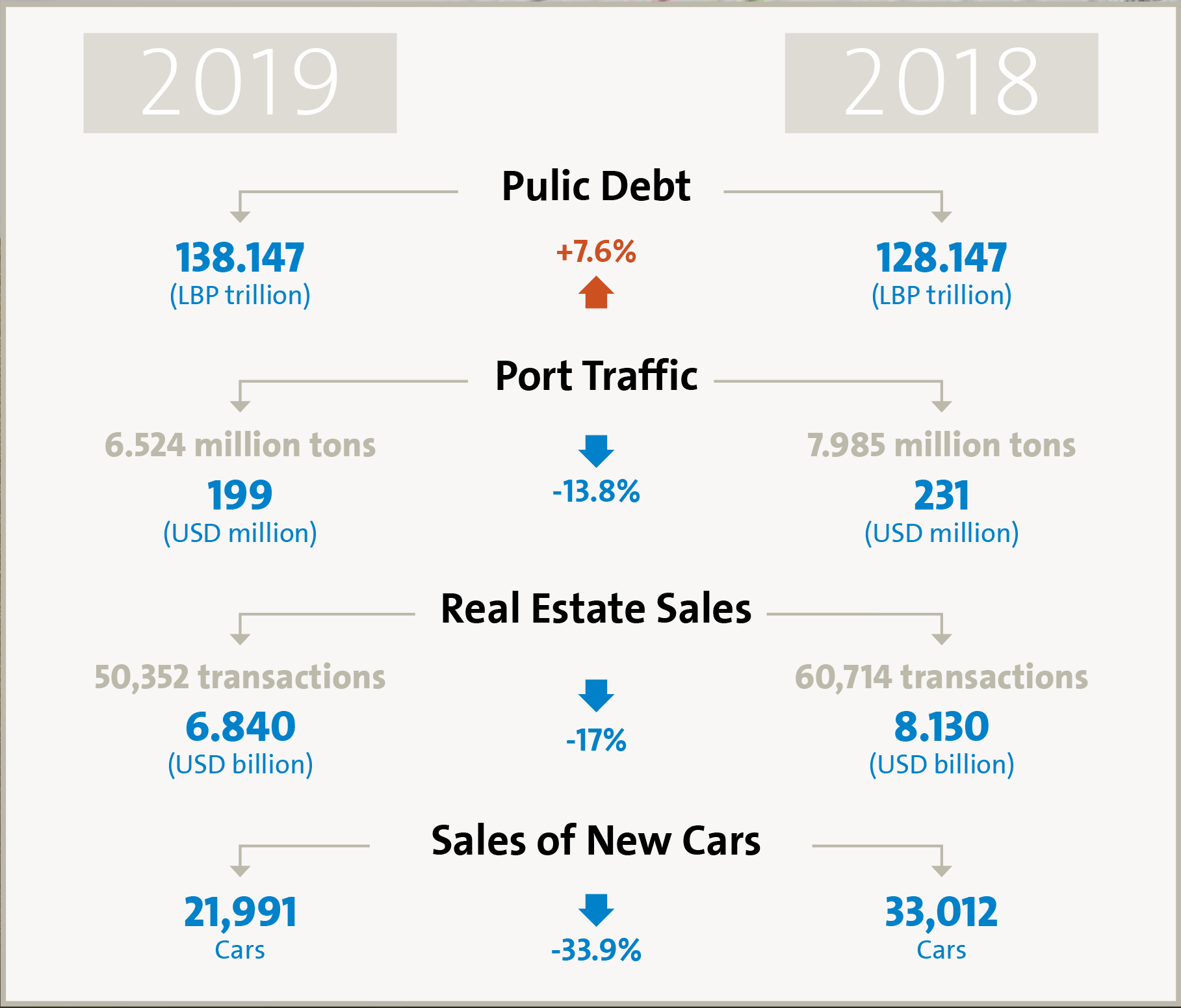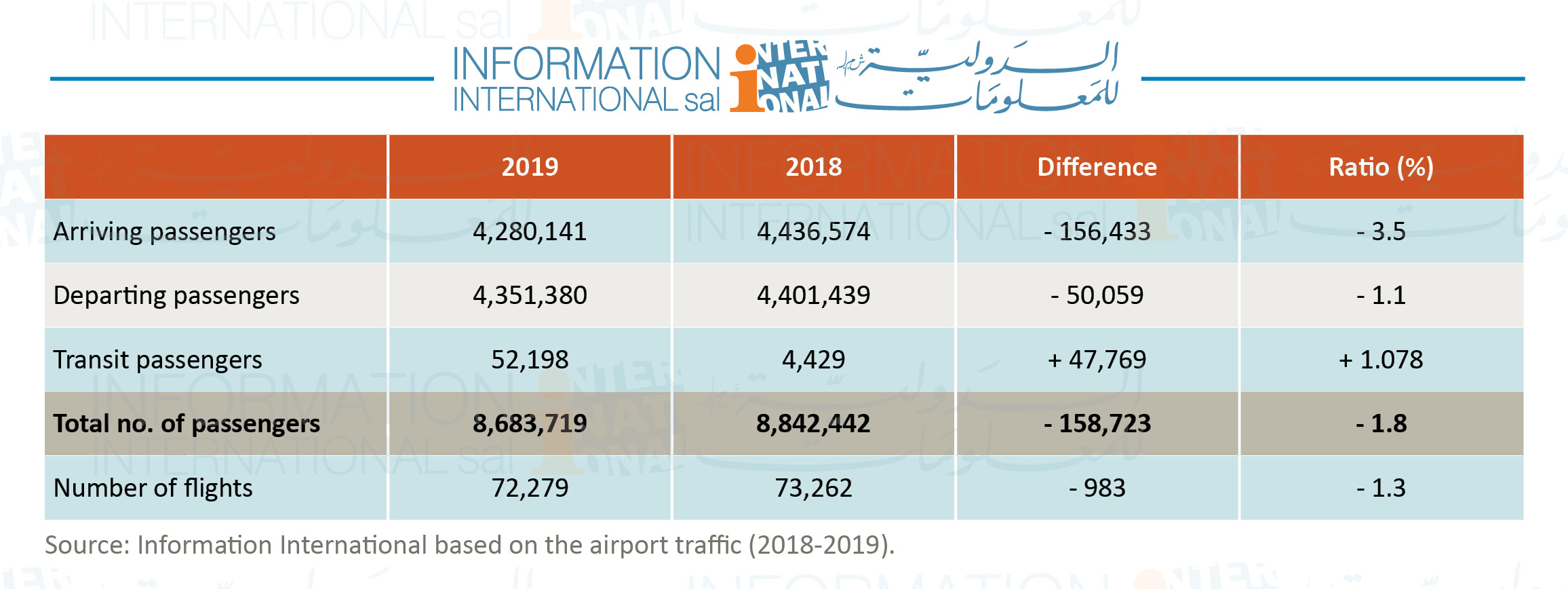Economic collapse looms as indicators turn bearish!
Economic collapse looms as indicators turn bearish!
All the financial, economic, monetary and social indicators have shown a downward trend by the end of 2019, indicating a rapid economic collapse. If no corrective measures are to be taken in 2020, the Lebanese economy will entirely collapse, turning Lebanon into an unstable country with indecent living conditions and causing further disruption, fragmentation and perhaps wars.

1-Public debt: USD 91.6 billion
Public debt has reached LBP 138.147 trillion (USD 91.6 billion) in 2019, registering an increase of LBP 9.8 trillion (USD 6.5 billion) or 7.6% compared to 2018. It had increased during the last month of the year by USD 2.16 billion.
2-Public finances: a 30% deficit
As shown in Table No. 1 below, the public budget approved in July 2019 was quite different from expectations. The cost of salaries, wages, and public debt service has amounted to LBP 15 trillion during the first ten months of 2019, i.e. 106% of the total revenues.
Table No. 1: Budget revenues and expenditures between estimates and actual values.

3-Balance of payments: a deficit of USD 4.3 billion
The balance of payments has recorded a deficit of USD 4.350 billion at the end of 2019, compared to USD 4.823 billion in 2018, bringing the total accumulated deficit since 2011 to around USD 17.513 billion. This means that the total surplus in the balance of payments for the period 1999-2019 has been mostly exhausted and only 6.6 billion has left.
4-Crime and theft rates show an improvement
The security situation was more positive in 2019 than in 2018 as some indicators, except suicides, have declined.
Car theft
724 cars were stolen in 2019 compared to 743 cars in 2018. Yet, after recovering numerous cars, the total has stood at 514 in 2019 compared to 544 in 2018, i.e. a decline of 5.5% (30 cars).
Death toll
The death toll reached 109 in 2019 compared to 121 in 2018, i.e. a decline by 10%.
Suicides
In 2019, there were 169 recorded suicides, up from 155 in 2018, i.e. an increase of 14 suicides or 8.3%.
Car accidents
4,207 car accidents were recorded in Lebanon in 2019, with 498 dead and 5,355 injured, compared to 4,719 (with 500 deaths and 6,195 injured) in 2018. Thus, the number of deaths has levelled off, the number of injuries has declined by 13.6% and the rate of car accidents by 11%.
5-Real estate sales: a 15.8% decline
The real estate transactions (sale and purchase) have decreased in 2019, reaching 50,352 (worth USD 6.840 billion) compared to 60,714 transactions (worth USD 8.130 billion) in 2018, i.e. a decline of 17% in transactions and of 15.8% in value.
What is noteworthy is that the number of transactions has increased in December 2019 (and kept rising in January 2020 due to the banking crisis). It has reached 6,189 and valued at USD 1.1 billion.
6-Sales of new cars: a 33.4% decline
The sales of new cars have decreased from 33,012 cars in 2018 to 21,991 in 2019 i.e. a decline of 11,021 cars or 33.9%.
The Korean Kia has continued to rank first with 3,205 vehicles sold, followed by Toyota (2,479) and Nissan (2,349). Lebanon has also imported 51,000 used cars.
7-Airport traffic: a 1.8% decline
As shown in Table No. 2 below, the passenger traffic at Rafic Hariri International Airport has decreased by 1.8%.
Table No. 2: Rafic Hariri International Airport traffic (2018-2019).

8-Number of tourists: a 1.4% decline
Although there were indicators and hopes that the number of tourists would increase in 2019, the outcome had been disappointing. The number of tourists has dropped to 1,963,320 compared to 1,963,917 in 2018, i.e. a decline of 27,597 tourists or 1.4%. European tourists ranked first (720,000), followed by Arab tourists (574,000).
9-Licensed building areas: a 40% decline
The licensed building areas have decreased to 5.403 million square meters in 2019, compared to 9.030 million square meters in 2018, i.e. a decline of 3.627 square meters or 40%. As a sign of great decline, the areas licensed in 2015 reached 12.3 million square meters and have been declining in the following years.
10- Value of mutual checks: a 14.4% decline
The number of mutual checks has decreased from 11.9 million in 2018 to around 9.9 million in 2019 (i.e. a decline of 16.4%). In terms of value, they have decreased by about 14.4%, from LBP 100 trillion in 2018 to LBP 86 trillion in 2019. The value of checks in foreign currencies has constituted 61.1% of mutual checks in 2019 compared to 66.7% in 2018.
11-Inflation index: a 6.7% increase
According to the Central Administration of Statistics (CAS), the inflation index has increased by 6.7% in 2019 due to the increase that occurred in the last two months of the year. There are estimates that the actual rate of inflation has exceeded 15%.
12-Decline of trade deficit: USD 15 billion deficit
The trade deficit has decreased from USD 17.028 billion in 2018 to USD 15.508 billion in 2019.. Imports have declined from USD 19.980 billion to USD 19.239 billion, while exports have increased from USD 2.952 billion to USD 3.731 billion.
In terms of imports to Lebanon, USA has ranked first (USD 1.705 billion), followed by China (USD 1.627 billion). As for exports, Switzerland ranked first (USD 1.062 billion), with the most exported items were jewels and ornaments manufactured in Lebanon, followed by the United Arab of Emirates (USD 439 million).
13-Beirut Port traffic: a 18% decline
The freight traffic at the Port of Beirut has fallen by 18.2% in 2019. The total cargo volume reached 6.524 million tons compared to 7.985 million tons in 2018. As for the port’s revenues, they have declined from USD 231 million to USD 199 million.
14-Deposits in the banking sector: a decline of USD 14.8 billion
Worsening in the last three months of 2019, the financial, monetary and economic crisis in Lebanon has reflected a significant decline in the banking sector’s assets and customer deposits. The combined budget has dropped from USD 249.5 billion in 2018 to USD 216.7 billion in 2019, i.e. a decline of USD 32.8 billion or 13.1%.
As for the customers’ deposits, they have decreased from USD 178.560 billion in 2018 to USD 163.760 billion in 2019, i.e. by USD 14.8 billion or 8.2%. Moreover, the deposit dollarization rate has strikingly increased from 70.6% in 2018 to 76% in 2019.
15-Bank loans: a decline of USD 9.6 billion
Bank loans to the private sector have decreased from USD 59.4 billion in 2018 to USD 49.8 billion in 2019, i.e. a decline of USD 9.6 billion or 16.2%.
16-Cement deliveries: a 32% decline
Cement deliveries have shown a drop from 4.7 million tons in 2018 to 3.2 million tons in 2019, i.e. a decline of 32%. The highest quantity of cement was delivered in 2013 and amounted to 5.8 million tons.
17-BDL reserves: a decline of USD 2.4 billion
BDL foreign currency reserves have decreased (according to the biweekly statement of financial position) from USD 39.67 billion at the end of 2018 to USD 37.27 billion in 2019, i.e. a decline of USD 2.4 billion or 6%.
18- Stock market trading: a rise of USD 268 million
The number of shares traded on the Beirut Stock Exchange (BSE) have increased by 121% to 199 million in 2019, up from 90 million in 2018. Their values have also increased from USD 633 million in 2018 to USD 902 million in 2019, i.e. a rise of 42.3%.
19-Cost of salaries and wages: an increase of USD 400 million
Spending on salaries, wages and end-of-service indemnities has reached USD 5.8 billion by end of October 2019, compared to USD 5.4 billion during the same period of 2018, i.e. an increase of USD 400 million or 7.4%.
20-Treasury transfers to EDL: USD 1.3 billion
By end of October 2019, the treasury transfers to Électricité du Liban (EDL) have reached USD 1.3 billion compared to USD 1.378 billion during the same period of 2018, i.e. a decline of USD 78 million or 5.7%.








Leave A Comment